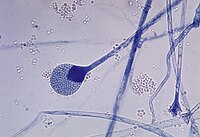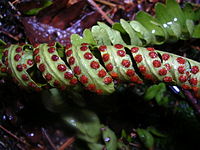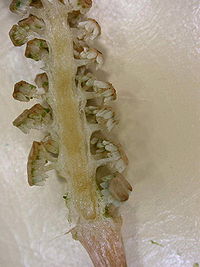This article needs additional citations for verification. (April 2018) |






A sporangium (from Late Latin, from Ancient Greek σπορά (sporá) 'seed' and ἀγγεῖον (angeîon) 'vessel'); pl.: sporangia)[2] is an enclosure in which spores are formed.[3] It can be composed of a single cell or can be multicellular. Virtually all plants, fungi, and many other groups form sporangia at some point in their life cycle. Sporangia can produce spores by mitosis, but in land plants and many fungi, sporangia produce genetically distinct haploid spores by meiosis.
- ^ "Life Cycle of a Moss - Infographic". STEM Lounge. 2018-09-13. Retrieved 2021-02-25.
- ^ "sporangium". Lexico UK English Dictionary. Oxford University Press. Archived from the original on May 28, 2020.
- ^ Rost, Thomas L.; et al. (2006). Plant Biology (2nd ed.). Thompson Brooks/Cole. ISBN 9780495013938.